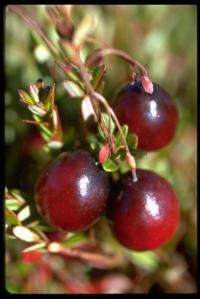Pest preferences for cranberry cultivars determined

To determine whether insect herbivores have a feeding preference for certain cultivars of cranberry, researchers investigated the phenolic profiles in the foliage of two cranberry cultivars, then isolated and identified compounds that differed between the two cultivars. Gypsy moth larvae demonstrated a significant feeding preference for 'Howes' over 'Early Black' cranberry. Red-headed flea beetle adults demonstrated a similar, but not statistically significant, trend, and cranberry weevil preferred neither cultivar.
Cranberry is an important commercial crop in states such as Massachusetts, Wisconsin, New Jersey, Washington, and Oregon. Insects and disease can pose serious problems for growers trying to realize profits in heavy cranberry production regions. Since cranberry is a perennial crop, pest damage can have a particularly significant negative impact in the next growing season.
By studying feeding preferences of insects, entomologists have reported that several insects prefer some cranberry cultivars over others. For instance, several insect herbivores have been anecdotally reported to prefer 'Howes' cranberry leaves over those of 'Early Black'. In a recent study published in the Journal of the American Society for Horticultural Science, scientists reported on a series of studies they designed to determine whether these anecdotal reports were accurate and to compare phenolic profiles in the foliage of 'Early Black' and 'Howes' for compounds that differ in concentration and could be possible feeding deterrents.
The scientists conducted bioassays to determine the feeding preferences of three cranberry pests. Gypsy moth larvae, cranberry weevil adults, and red-headed fleabeetle were studied in late June, early July, and early August, respectively, when they were at their most active on the bog. According to the research, gypsy moth larvae demonstrated a significant feeding preference for 'Howes' over 'Early Black'. Red-headed flea beetle adults demonstrated a similar, but not statistically significant, trend, whereas cranberry weevil preferred neither cultivar.
"Compounds giving rise to six peaks in the phenolic profile were significantly greater in concentration in 'Early Black' than 'Howes' on at least one of three sampling dates during the growing season", noted the study's corresponding author Justine Vanden Heuvel. "Five of these compounds were isolated from leaves harvested at the June time point coinciding with gypsy moth infestation and identified as: 5-O-caffeoylquinic acid, 3-O-p-coumaroylquinic acid, 5-O-p-coumaroylquinic acid, quercetin-3-O-galactoside, and quercetin-3-O-rhamnoside."
Vanden Heuvel said that the data suggests that these compounds warrant further investigation as possible insect-feeding deterrents. "The compounds identified in this study should be investigated further to determine their ability to reduce feeding and/or growth of foliage feeders in cranberry. If a feeding deterrent is identified, this deterrent could have potential as a screening method for new cranberry cultivars. Breeding schemes and cultural practices could also be investigated to increase the presence and concentration of the deterrent in cranberry leaves."
More information: journal.ashspublications.org/c … t/abstract/135/6/494
Provided by American Society for Horticultural Science












